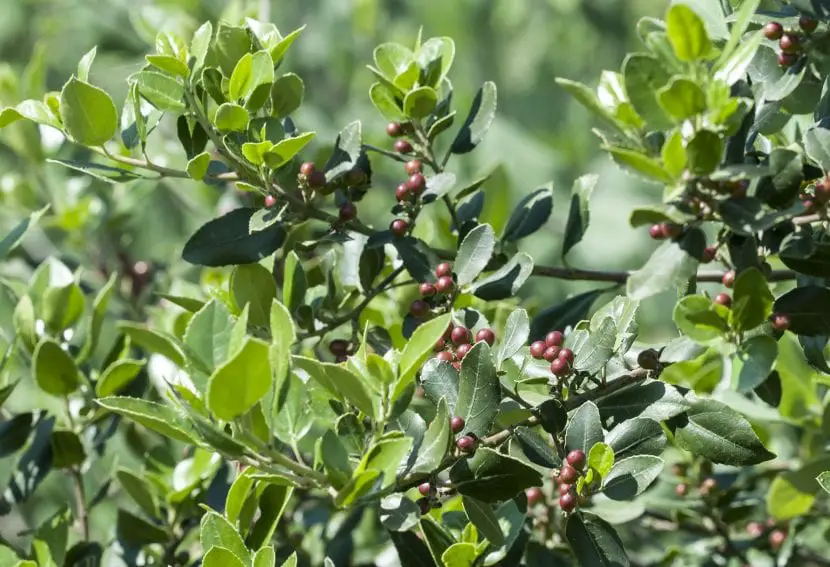
Image – Wikipedia, the free encyclopedia
The Phillyrea latifolia It is a tree that can be used as a protection hedge as a potted plant. As it remains evergreen, also during the summer it provides a very pleasant shade, so you will surely be able to enjoy it a lot.
What’s more, does not require very frequent waterings since it resists droughtas well as weak to moderate frosts. Do you want to know more about him? 🙂
Origin and characteristics of Phillyrea latifolia

Image – Wikimedia / Krzysztof Ziarnek, Kenraiz
Known as broadleaf, blackberry or barberry (do not confuse the latter with the Berber vulgaris) it is an evergreen tree native to southern Europe, northwestern Africa, and southwestern Asia. In Spain we find it in the Balearic archipelago, and in the peninsula in Catalonia, Aragon, Pyrenees, Cantabria and the Basque Country, as well as in the southern half.
Reaches a height of up to 9 metersalthough it can overcome them. Its crown is dense, highly branched, with smooth, whitish branches. The leaves are ovate, with the main veins well visible, and the margin serrated or entire. The flowers, which sprout in spring, are greenish-white and appear grouped in clusters between the leaves. The fruit is a globose and black drupe that measures about a centimeter and contains one or two seeds.
What are the care it requires?
If you want to have a copy, we recommend that you provide it with the following care:
Location
The Phillyrea latifolia is a plant that must be outsideif possible in an area where the sun shines directly the more hours the better (minimum four).
Earth
- the garden: grows on clay soils, and tolerates limestone. It must also be well drained and fertile.
- Pots: fill with universal substrate (for sale here!). The container to be used must have drainage holes so that the excess water can escape, thus avoiding rotting of the roots.
Irrigation
- the garden: during the first year it will be necessary to water about 2 times a week in summer and between 1 and 2 per week the rest of the year, but from the second you can gradually space the waterings. In the event that a minimum of 350-400mm per year is registered in your area from the third season that it is planted, you can stop watering.
- Flower pot: 2-3 times a week in summer, and somewhat less the rest of the year.
Subscriber

Image – Wikimedia Commons / K.vliet
From early spring to late summer It is advisable to fertilize, either with homemade or compound fertilizers. As homemade fertilizers you have the egg and banana shells, the ash (better if it is made of wood), green manure, or compost; and as compounds those sold in any nursery: the universal (for sale here!), or for green plants (for sale here!), among others.
Just keep in mind that if you opt for the latter, you must follow the instructions specified on the package to the letter since otherwise there could be a risk of overdose and the roots would burn.
Pruning
You don’t need it. Remove only dry, diseased, weak or broken branches in late winter, or in fall if the weather is mild.
Multiplication of the black pigeon
The Phillyrea latifolia multiplies by seeds in spring. You simply have to sow them in pots or seedling trays with universal substrate, place them outside in semi-shade, and keep the substrate always moist (but not flooded).
To achieve a higher germination and survival rate, it is important not to put the seeds too close together (ideally put 2-3 in the same pot or socket), and sprinkle sulfur (for sale here!) to prevent fungus. Sulfur is a natural fungicide that, if it is applied first in seedbeds and then after ringing, helps the seedlings to overcome the critical period (the first year of life).
Thus they will germinate in about 2 weeks, maximum one month.
Planting or transplanting time
Late winterwhen the risk of frost has passed. If you want to have it in the garden, it is advisable to make a planting hole of at least 1m x 1m so that its root system can adapt and resume its growth as soon as possible when loose soil is found.
And if what you want is to move it to a larger pot, do it only if you see roots coming out of the drainage holes, if you know in advance that it has been in that same container for a long time (at least one year), and / or if you see that hardly there is land.
Plagues and diseases
It’s very tough.
Rusticity

Image – Wikimedia / Xemenendura
The Phillyrea latifolia it resists frosts down to -7ºC. In addition, the maximum temperatures of up to 40ºC do not affect it, as long as the substrate or soil is somewhat humid.
What did you think of this tree? Without a doubt, it is a plant to take into account if you live in an area where drought is a recurring problem 😉.

